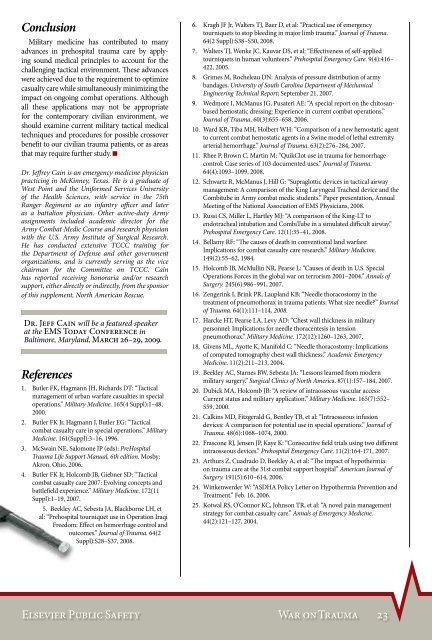Lessons Learned from a Decade of Conflict - Boekje Pienter
Lessons Learned from a Decade of Conflict - Boekje Pienter
Lessons Learned from a Decade of Conflict - Boekje Pienter
Create successful ePaper yourself
Turn your PDF publications into a flip-book with our unique Google optimized e-Paper software.
ConclusionMilitary medicine has contributed to manyadvances in prehospital trauma care by applyingsound medical principles to account for thechallenging tactical environment. These advanceswere achieved due to the requirement to optimizecasualty care while simultaneously minimizing theimpact on ongoing combat operations. Althoughall these applications may not be appropriatefor the contemporary civilian environment, weshould examine current military tactical medicaltechniques and procedures for possible crossoverbenefit to our civilian trauma patients, or as areasthat may require further study.Dr. Jeffrey Cain is an emergency medicine physicianpracticing in McKinney, Texas. He is a graduate <strong>of</strong>West Point and the Uniformed Services University<strong>of</strong> the Health Sciences, with service in the 75thRanger Regiment as an infantry <strong>of</strong>ficer and lateras a battalion physician. Other active-duty Armyassignments included academic director for theArmy Combat Medic Course and research physicianwith the U.S. Army Institute <strong>of</strong> Surgical Research.He has conducted extensive TCCC training forthe Department <strong>of</strong> Defense and other governmentorganizations, and is currently serving as the vicechairman for the Committee on TCCC. Cainhas reported receiving honoraria and/or researchsupport, either directly or indirectly, <strong>from</strong> the sponsor<strong>of</strong> this supplement, North American Rescue.Dr. Jeff Cain will be a featured speakerat the EMS Today Conference inBaltimore, Maryland, March 26–29, 2009.References1. Butler FK, Hagmann JH, Richards DT: “Tacticalmanagement <strong>of</strong> urban warfare casualties in specialoperations.” Military Medicine. 165(4 Suppl):1–48,2000.2. Butler FK Jr, Hagmann J, Butler EG: “Tacticalcombat casualty care in special operations.” MilitaryMedicine. 161(Suppl):3–16, 1996.3. McSwain NE, Salomone JP (eds): PreHospitalTrauma Life Support Manual, 6th edition. Mosby:Akron, Ohio, 2006.4. Butler FK Jr, Holcomb JB, Giebner SD: “Tacticalcombat casualty care 2007: Evolving concepts andbattlefield experience.” Military Medicine. 172(11Suppl):1–19, 2007.5. Beekley AC, Sebesta JA, Blackborne LH, etal: “Prehospital tourniquet use in Operation IraqiFreedom: Effect on hemorrhage control andoutcomes.” Journal <strong>of</strong> Trauma. 64(2Suppl):S28–S37, 2008.6. Kragh JF Jr, Walters TJ, Baer D, et al: “Practical use <strong>of</strong> emergencytourniquets to stop bleeding in major limb trauma.” Journal <strong>of</strong> Trauma.64(2 Suppl):S38–S50, 2008.7. Walters TJ, Wenke JC, Kauvar DS, et al: “Effectiveness <strong>of</strong> self-appliedtourniquets in human volunteers.” Prehospital Emergency Care. 9(4):416–422, 2005.8. Grimes M, Rocheleau DN: Analysis <strong>of</strong> pressure distribution <strong>of</strong> armybandages. University <strong>of</strong> South Carolina Department <strong>of</strong> MechanicalEngineering Technical Report; September 21, 2007.9. Wedmore I, McManus JG, Pusateri AE: “A special report on the chitosanbasedhemostatic dressing: Experience in current combat operations.”Journal <strong>of</strong> Trauma. 60(3):655–658, 2006.10. Ward KR, Tiba MH, Holbert WH: “Comparison <strong>of</strong> a new hemostatic agentto current combat hemostatic agents in a Swine model <strong>of</strong> lethal extremityarterial hemorrhage.” Journal <strong>of</strong> Trauma. 63(2):276–284, 2007.11. Rhee P, Brown C, Martin M: “QuikClot use in trauma for hemorrhagecontrol: Case series <strong>of</strong> 103 documented uses.” Journal <strong>of</strong> Trauma.64(4):1093–1099, 2008.12. Schwartz R, McManus J, Hill G: “Supraglottic devices in tactical airwaymanagement: A comparison <strong>of</strong> the King Laryngeal Tracheal device and theCombitube in Army combat medic students.” Paper presentation, AnnualMeeting <strong>of</strong> the National Association <strong>of</strong> EMS Physicians, 2008.13. Russi CS, Miller L, Hartley MJ: “A comparison <strong>of</strong> the King-LT toendotracheal intubation and CombiTube in a simulated difficult airway.”Prehospital Emergency Care. 12(1):35–41, 2008.14. Bellamy RF: “The causes <strong>of</strong> death in conventional land warfare:Implications for combat casualty care research.” Military Medicine.149(2):55–62, 1984.15. Holcomb JB, McMullin NR, Pearse L: “Causes <strong>of</strong> death in U.S. SpecialOperations Forces in the global war on terrorism 2001–2004.” Annals <strong>of</strong>Surgery. 245(6):986–991, 2007.16. Zengerink I, Brink PR, Laupland KB: “Needle thoracostomy in thetreatment <strong>of</strong> pneumothorax in trauma patients: What size needle?” Journal<strong>of</strong> Trauma. 64(1):111–114, 2008.17. Harcke HT, Pearse LA, Levy AD: “Chest wall thickness in militarypersonnel: Implications for needle thoracentesis in tensionpneumothorax.” Military Medicine. 172(12):1260–1263, 2007.18. Givens ML, Ayotte K, Manifold C: “Needle thoracostomy: Implications<strong>of</strong> computed tomography chest wall thickness.” Academic EmergencyMedicine. 11(2):211–213, 2004.19. Beekley AC, Starnes BW, Sebesta JA: “<strong>Lessons</strong> learned <strong>from</strong> modernmilitary surgery.” Surgical Clinics <strong>of</strong> North America. 87(1):157–184, 2007.20. Dubick MA, Holcomb JB: “A review <strong>of</strong> intraosseous vascular access:Current status and military application.” Military Medicine. 165(7):552–559, 2000.21. Calkins MD, Fitzgerald G, Bentley TB, et al: “Intraosseous infusiondevices: A comparison for potential use in special operations.” Journal <strong>of</strong>Trauma. 48(6):1068–1074, 2000.22. Frascone RJ, Jensen JP, Kaye K: “Consecutive field trials using two differentintraosseous devices.” Prehospital Emergency Care. 11(2):164-171, 2007.23. Arthurs Z, Cuadrado D, Beekley A, et al: “The impact <strong>of</strong> hypothermiaon trauma care at the 31st combat support hospital” American Journal <strong>of</strong>Surgery. 191(5):610–614, 2006.24. Winkenwerder W: “ASDHA Policy Letter on Hypothermia Prevention andTreatment.” Feb. 16, 2006.25. Kotwal RS, O’Connor KC, Johnson TR, et al: “A novel pain managementstrategy for combat casualty care.” Annals <strong>of</strong> Emergency Medicine.44(2):121–127, 2004.Elsevier Public Safety War on Trauma 23
















